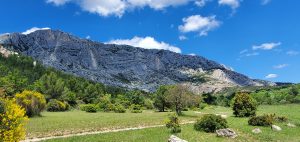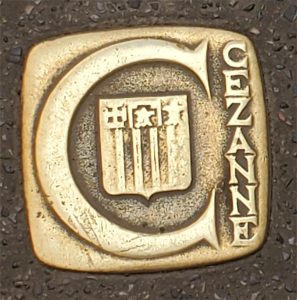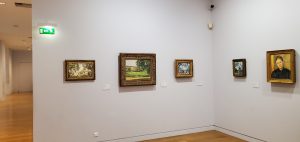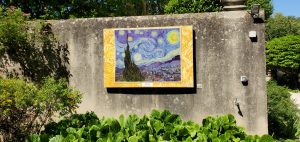If you are a fan of Impressionism you will most likely have already seen the south of France. According to Fodor’s, “Artists have been drawn to the south of France for generations, awed by its luminous colors and crystalline light. Monet, Renoir, Gauguin, and Van Gogh led the way, followed by Léger, Matisse, Picasso, Chagall, and Cocteau. Cézanne had the good fortune to be born in Provence, and he returned there throughout his life.”

 Aix-en-Provence is very proud of their native son Paul Cezanne (1839 – 1906) who was born and died in the city. We spent a fun morning following the Cezanne trail through town, a walk marked by the letter C in the pavement. At the Tourist Office visitors can pick up brochures for a self guided walking tour or take a guided tour of the Cézanne Trail thru the Tourist Office.
Aix-en-Provence is very proud of their native son Paul Cezanne (1839 – 1906) who was born and died in the city. We spent a fun morning following the Cezanne trail through town, a walk marked by the letter C in the pavement. At the Tourist Office visitors can pick up brochures for a self guided walking tour or take a guided tour of the Cézanne Trail thru the Tourist Office.

It begins at the bronze statue of Paul Cézanne at the end of Cours Mirabeau near said Tourism office and continues with landmarks such as the school he attended as a child, the building where he was born, the houses of his friends, the cafés where he met other artists, and the church where he married his wife Hortense Fiquet.
Leaving the centre of town you can visit his studio where he worked between 1902 and his death in 1906, when he wasn’t painting en plein air (outdoors) of course. A further 10 – 15 minute walk north will take you to Terrain des Peintres (Painters’ Park) where he often set up his easel to paint the Sainte-Victoire Mountain and surrounding landscape. Several copies of his painting are posted there to help illustrate his work. Both of these sites are accessible by bus as it is a longer hike.
The Granet Museum also displays a number of works by Cezanne. These are a few of his lesser known pieces however, as the curator of the museum during Cezanne’s life was not a fan and failed to collect his better works before he became famous, thus pricing them out of the budget of a smaller local museum.

Another popular painter who loved in the region was Vincent Van Gogh (1853 – 1890). Although born in the Netherlands Van Gogh moved to Paris in 1886 where he met and worked with some of the best known artists of the day. In 1888 he left Paris for Arles in the south of France, desperate to find colour after the dreary grey of Paris.

 His work there was some of his most famous and often cited as where he finally found his individual style. Unfortunately he also suffered from mental instability during that time and spent more than a year in an asylum in Saint-Rémy-de-Provence. He continued to paint there, both what he could see and from memory. The hospital, St Paul de Mausole, is now a museum and offers insight into his work and his time spent there. A tour there and through the city of Arles is reflected in so much of his work.
His work there was some of his most famous and often cited as where he finally found his individual style. Unfortunately he also suffered from mental instability during that time and spent more than a year in an asylum in Saint-Rémy-de-Provence. He continued to paint there, both what he could see and from memory. The hospital, St Paul de Mausole, is now a museum and offers insight into his work and his time spent there. A tour there and through the city of Arles is reflected in so much of his work.
Van Gogh did not achieve success when he was alive. Of the more than 800 oil paintings and 700 drawings that constitute his life’s work, he sold only one in his lifetime. Desperately poor and homesick he took his own life in 1890. Within the span of a century, however, Van Gogh has become perhaps the most recognized painter of all time.
Before travelling anywhere in Europe, and especially to the south of France, spend some time looking into the art of that region and its most prolific and beloved artists. You cannot avoid it so you are better off to embrace and enjoy the impact the region has had on art over the decades.
